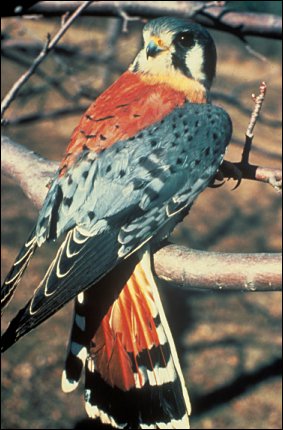
ContextKingdom: AnimaliaPhylum: Chordata Subphylum: Vertebrata Class: Aves Order: Falconiformes Family: Falconidae |
 |
Photograph by Dave Menke, courtesy of the U.S. Fish and Wildife Service |
Generally, the American kestrel is 19-21 cm in length with an average wingspan of 50-60 cm. Excepting the Seychelles kestrel, the American kestral is the smallest species in the genus Falco (McCollough, 2001). The American kestrel is also North America's most colorful falcon. Males and females have mustache and sideburn marks. Males have blue gray wings, a reddish back, and a reddish tail with a single sub-terminal tail band. Females have reddish wings but are darker from the wrist to the tip of the wing and reddish backs. The female has a reddish tail with multiple narrow bands (Gothard, 2003).
Falco sparverius nests in tree cavities, woodpecker holes, crevices of buildings, holes in banks, nest boxes, or rarely, old nests of other birds. The American kestrel is highly adaptable behaviorly and lives just about everywhere, as long as there is some open ground for hunting and conspicuous places on which to perch (e.g., telephone wires) (McCollough, 2001).
The American kestrel permanently inhabits (without seasonal migration) North and South America from near the tree-line in Alaska and Canada and south to Tierra del Fuego. The bird can also be found in the West Indies, the Juan Fernandez Islands, and Chile. It is largely absent from heavily forested areas, including Amazonia (Cade, 1982).
In the summer, American kestrels hunt in the early morning and evening, eating large insects (mainly grasshoppers). During winter, they hunt throughout daylight hours and eat small mammals (mice and sparrow-sized birds), lizards, scorpions, and amphibians (Cade, 1982).
For up to 6 weeks before egg laying, females are promiscuous, mating with two or three males. Once a female settles with one mate, the pair mate frequently until egg laying. Three to seven eggs are laid (usually 4 or 5) over a period of 2 or 3 days. Eggs are white, cream or pale pink with an average size of 35 x 29 mm (Amadon and Brown, 1968). Incubation generally begins with the second to the last egg laid and lasts 29 to 31 days. The female does the majority of the incubation, with the male providing her with food. Males have been known to occasionally assist with incubation by sitting on the eggs. Both sexes have brooding patches (Robinson, 2002).
The common name "sparrow-hawk" is a misnomer because the diet of Falco sparvarius is not even close to being exclusively made up of sparrows. Its other common name, "American kestrel," is more appropriate (McCollough, 2001). The American kestrel has three basic vocalizations, the most common being the high-pitched "klee" or "killy." This call is used as a rapid series ("killy, killy, killy, killy") when the kestrel is upset or excited. Kestrels also have a "whine" and a "chitter" in their repertoire, and these are both used during male-female interactions such as courtship and copulation (Sibley, 2000).
Cade, T. J. 1982. The falcons of the world". Cornell University Press, Ithaca.
Gothard, G. 2003. "Falco sparverius" (on-line), Birds of Prey at Boteo.com. Accessed March 01, 2006 at http://www.buteo.com/falcons.html.
McCollough, K. 2001. "Falco sparverius" (On-line), Animal Diversity Web. Accessed March 01, 2006 at http://animaldiversity.ummz.umich.edu/site/accounts/information/Falco_sparverius.html.
Robinson, K. 2002. "The American Kestrel and Iowa's Nest Box Program" (On-line), Enviro-Explorers. Accessed March 01, 2006 at http://www.enviro-explorers.com/kestrel_web_pages/species_description_page.htm#Geographic%20Range.
American: referring to its New World distribution.
Kestrel: probably from the Old French kerserl or caserel which is derived from Latin crepicella meanig to rattle or creak, referring to its call.
Falco: from Latin falc meaning "falcon".
sparverius: Latin meaning "relating to a sparrow", alluding to its size and prey.
Other names:
American Sparrow Hawk, Rusty-crowned Falcon, Windhover; Spanish: Cernícalo chitero, gavilancito enano.
Males with two mustache marks on cheeks; crown bluish with central rufous spot; reddish tail with only one dark band near tip; upper wing coverts bluish; female similar to male but with rufous brown crown, tail rufous and banded, upper wing coverts rufous brown with black banding. Length, 9"; wingspan, 22".
Scott M. Cutler, Curator of Collections and Exhibits; Curator of Ornithology
Last Update: 11 March 2006